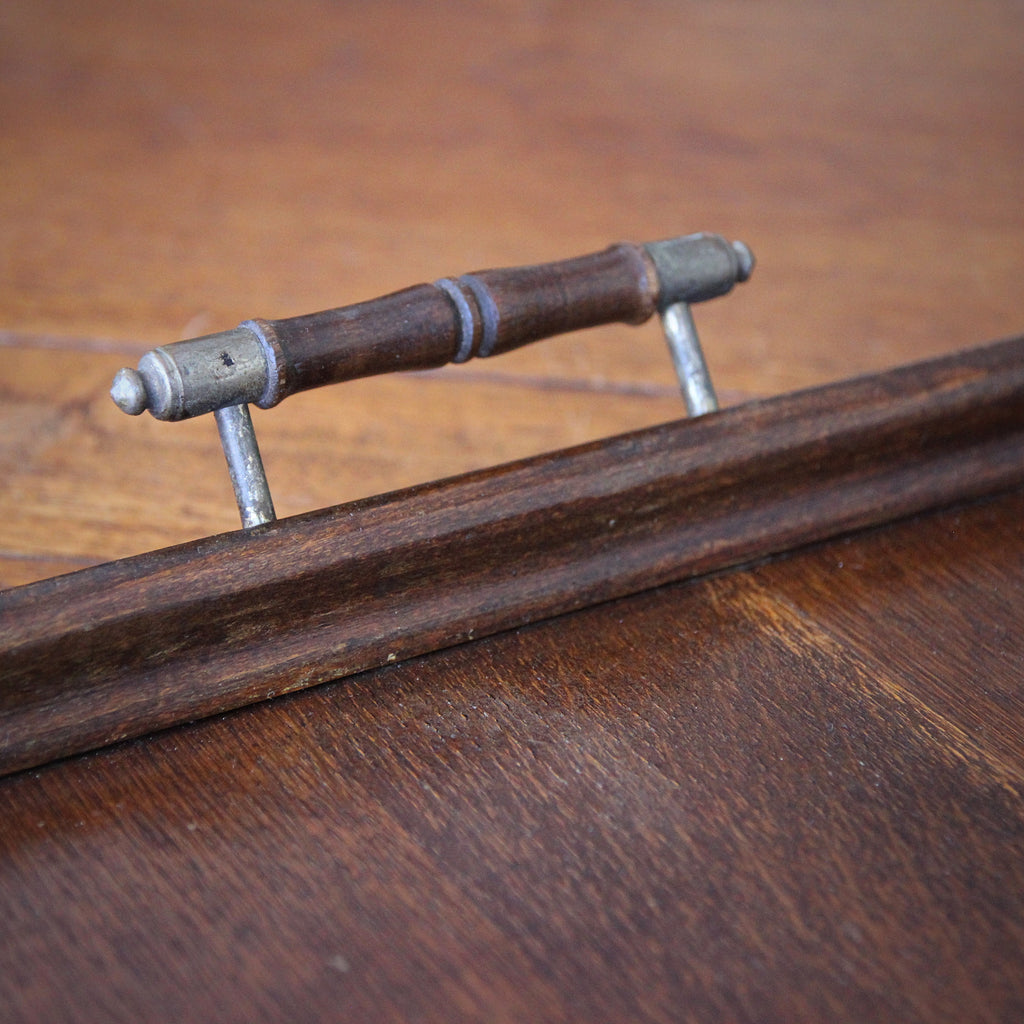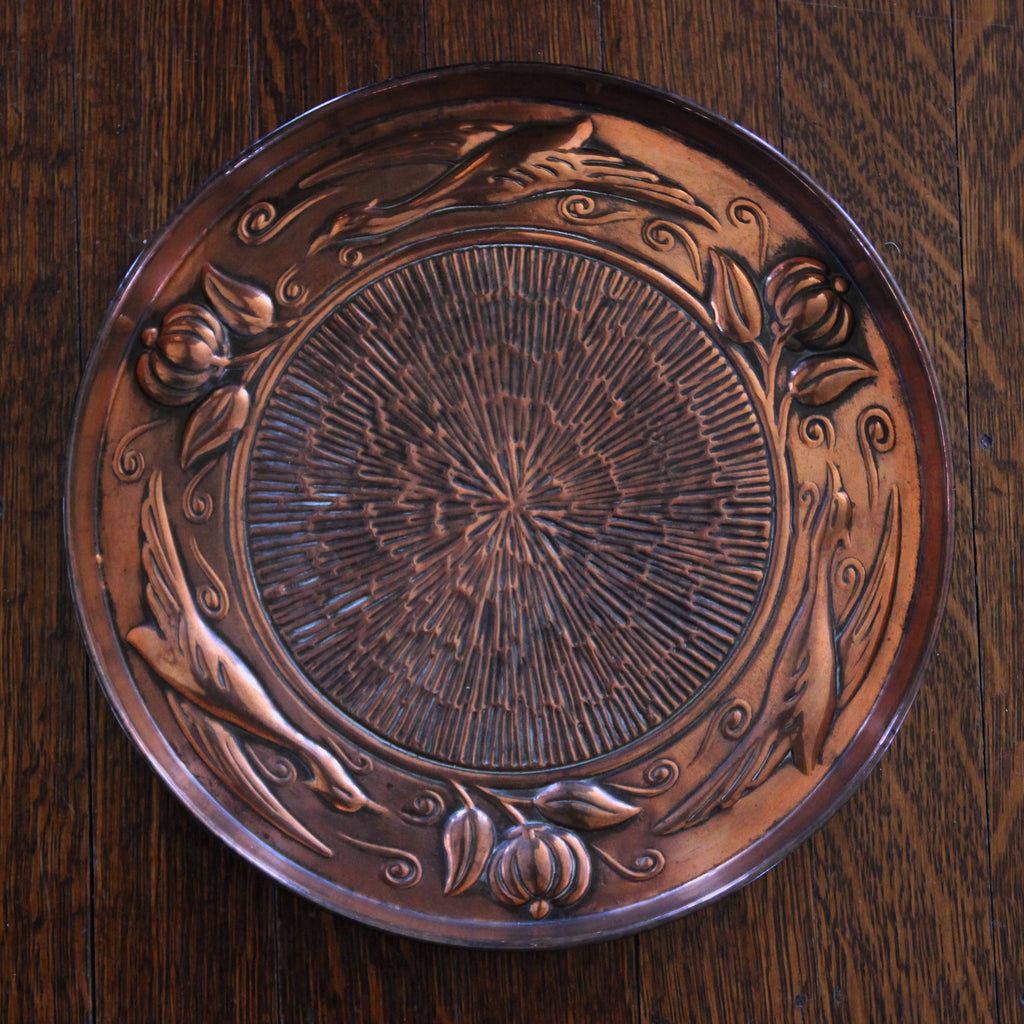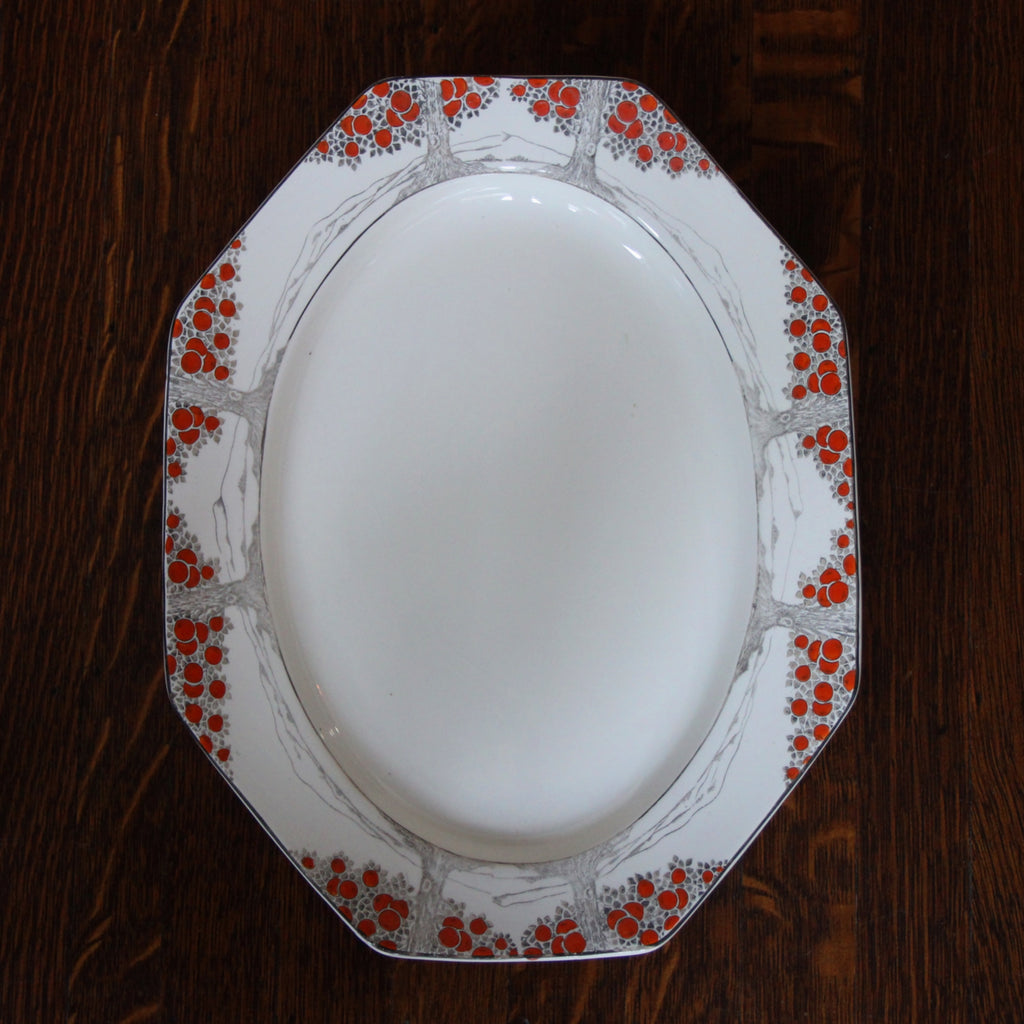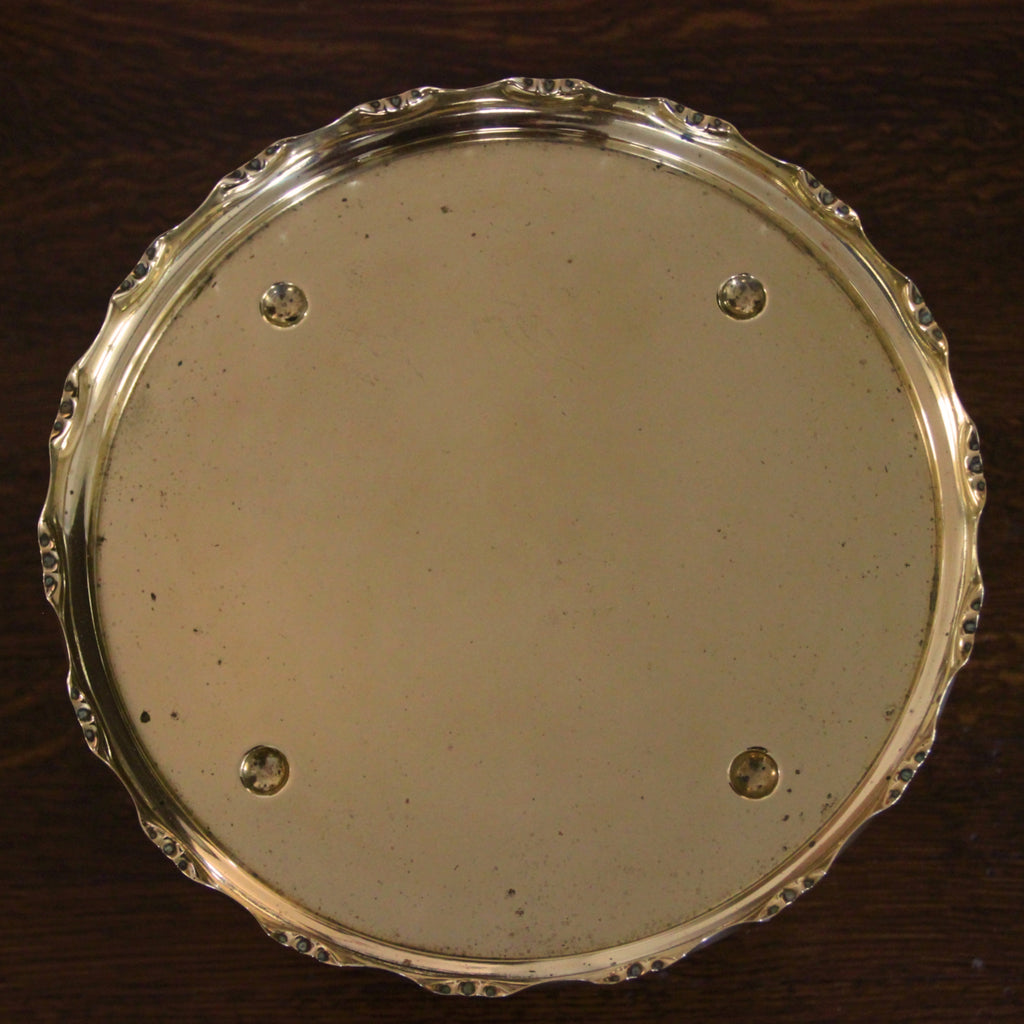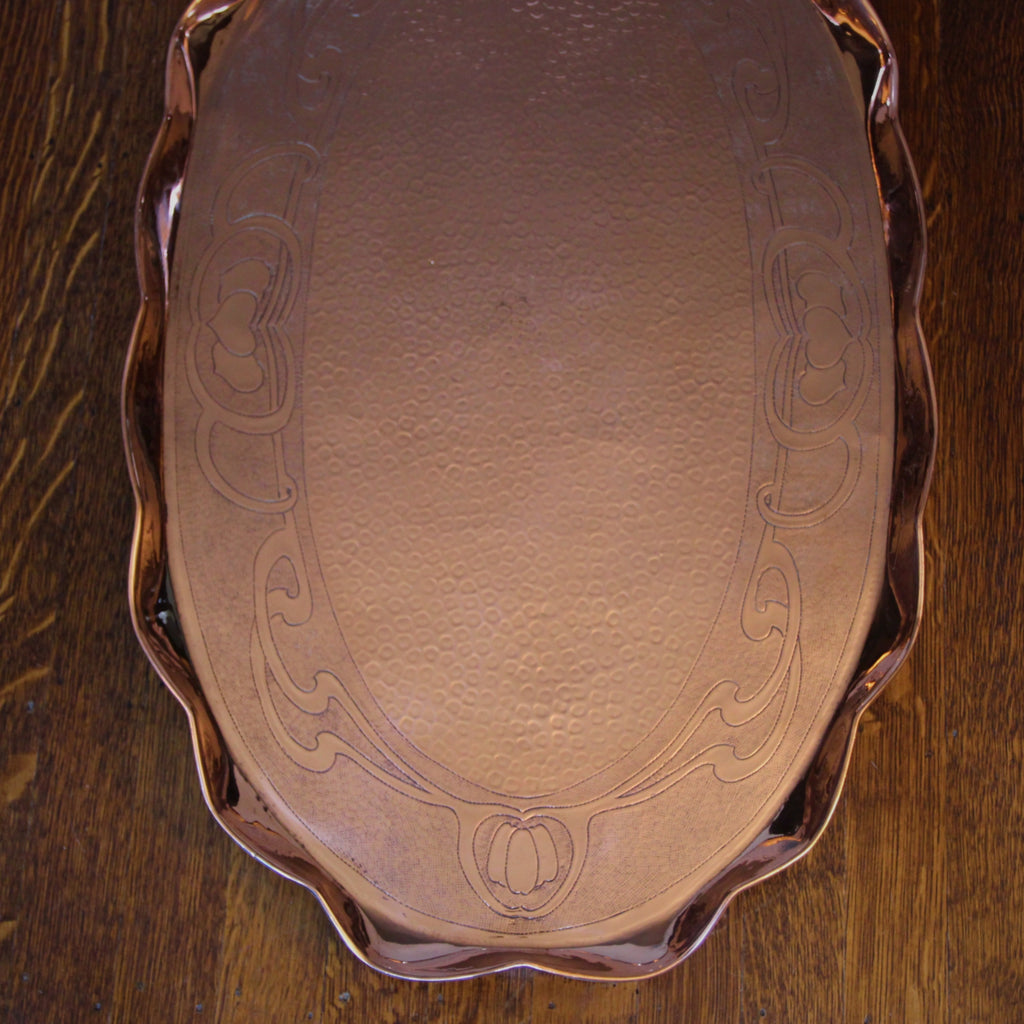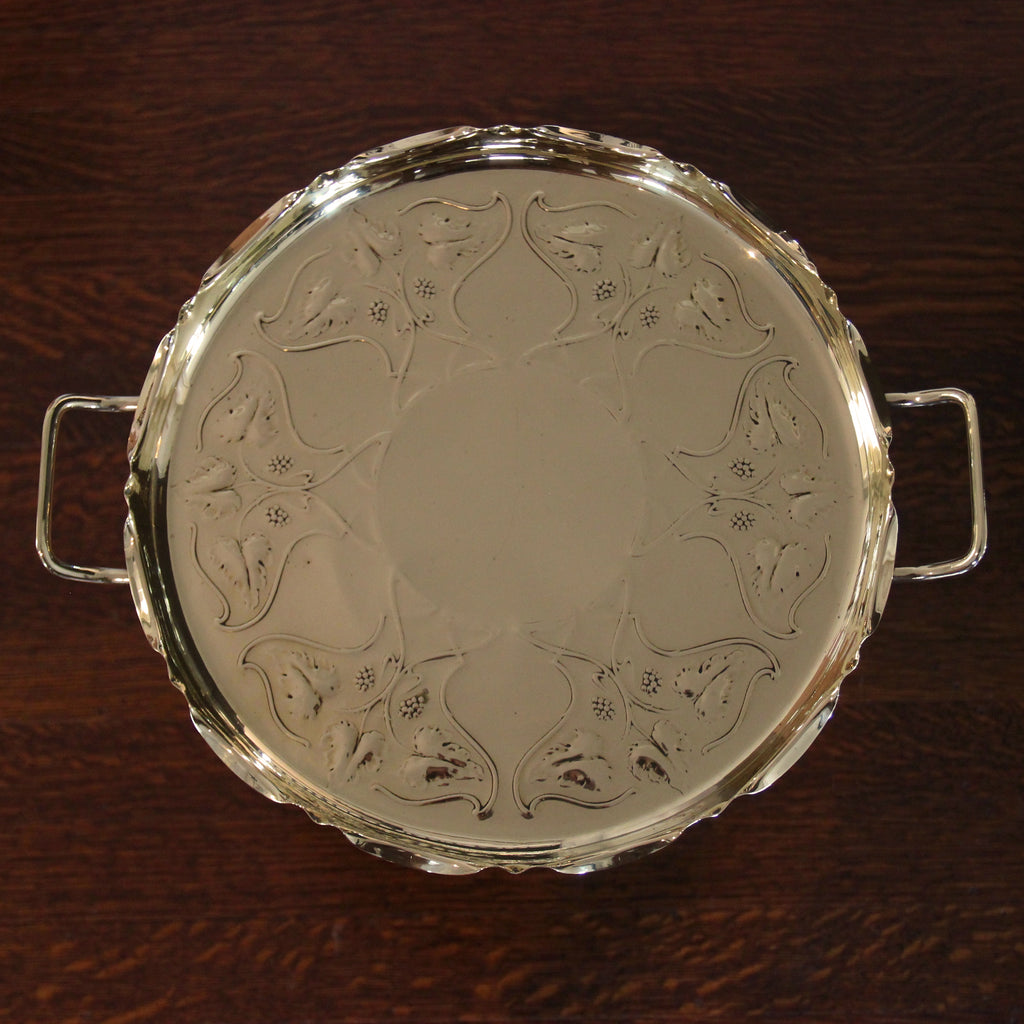JOURNAL — Trays RSS
When is a tray not a tray? Perhaps when it's too beautiful to cover-up and use—like this Belgian Art Nouveau bronze tray. It was made by G. Huygens, a Belgian sculptor of Dutch ancestry. What this small tray does—superbly—is to provide a sculpted decorative accent upon a table top or low shelf. It would be useful for presenting business cards, offering small (wrapped) candies, or as a caddy for wallets and mobile phones (though I would avoid scratching it with coins or keys).
While the works of G. Huygens can be found at the occasional auction, there is a surprising lack of biography to be found about him.
Extra Help for the Holidays
Trays are amongst the simplest—yet most useful—of household accoutrements. Compared to carrying-by-hand, trays allow one to transport three (or four) times the amount of volume of that which must be carried. Trays can be fancy and decorative or they can be handsomely utilitarian (like the Edwardian English Oak Butler's Tray, shown above). I use trays when setting the table. In the kitchen, I pile-on all the plates, glasses, napkins, silverware, and serving pieces (pitchers and utensils). Using the tray allows me to make one trip to the dining room. I use trays when serving my guests (first drinks, then supper, then dessert). And the tray is useful for clearing-away the table at the end of the night. When I head...
Houze Wares
It's ten days 'til Christmas! Is your Holiday bar cart ready-to-go? Southwestern Pennsylvania (as well as Ohio and West Virginia) was the locus of much American glassmaking in the Nineteenth and Twentieth Centuries. The region had all the elements necessary for the manufacture of glass: silica (the raw material), heat (provided by coal or gas), labor (much of it from Eastern European glass-producing countries), and transport for the finished goods (that is, the rivers which lace the area). Another factor helped promote glassmaking in this area: the Allegheny mountains which made East-West transport difficult (especially when porting delicate glass merchandise). Western Pennsylvania was able to produce glass for (and deliver it to) the growing Midwest (without having to lug it...
Tôle
When Europeans first started trading with the East—China, Japan, India, Southeast Asia—a whole new world of design and style was revealed to Westerners. Asian artisans created masterful works—ceramics, lacquerware, textile weaving, printmaking—which enchanted the Europeans. These items, when imported to the West, were very expensive. Asian decorative arts became a status symbol of the rich and worldly. Only the wealthiest Europeans and Americans could afford to collect the real thing. But the desire for "Oriental" design permeated more than just the upper reaches of Western society. Consumers in the growing Middle Class (especially in the Nineteenth Century) wanted "a taste of the exotic East" in their homes, too. This broad demand led Western designers and craftsmen to try to emulate...
August's Birth Flower
Yesterday we presented August's birthstone, the Peridot. Today, let's talk about August's birth flower, the Poppy.
Poppies are thought to have originated in the Eastern Mediterranean and have been cultivated by Western and Central Europeans from about 6,000 BC. Early on, people recognized the analgesic properties of the plant. Ancient Egyptian doctors had their patients chew a mouthful of poppy seeds to relieve pain. Even today, poppies are cultivated as a source of opium, morphine and codeine—powerful narcotics. Recent and reckless use of Oxycodone, which is synthesized from poppies, has caused grave problems for so many. And the illicit drug trade has profited from the poppy—through the sale of heroin, another derivation of the flower's seeds.
Welcome, June
June is here—with her flower, the Rose.
Roses have grown in the wild for tens of millions of years. 50-million-year-old rose fossils from the Eocene Period (which means, roughly, "The New Dawn") have been uncovered by archaeologists in Colorado. Roses are depicted in Minoan art (circa 1400 BC) and in Egyptian tomb paintings shortly thereafter. And ornamental roses are known to have been cultivated by the Chinese, Persians and Mediterraneans from about 500 BC. There are over 300 different species of natural roses and tens-of-thousands of man-made "cultivars" (that is, special varieties of roses purposely bred to accentuate selected traits like color, size, fragrance, form or hardiness).
Très Convenient
The older I get, the more I appreciate just how convenient a good tray can be. Of course, I have always used a tray when serving my guests at table. But I now find myself pulling-out the tray when I set or clear the table (carrying far more plates, cutlery, napkins or glassware than I could handle without it). The tray makes carrying safer and easier—and it cuts-in-half the number of back-and-forth trips I have to make. I also use a tray when moving merchandise around my home or showroom—and appreciate the reduced number of trips I have to make up or down a flight of stairs. The tray makes it easier to organize LEO Design's collection of cufflinks (which...
Art Nouveau Belge
This Belgian Art Nouveau bronze platter ticks so many boxes for me. It's Art Nouveau. It's Belgian. It is highly sculptural. It is cast of heavy bronze. And it features an exuberant spray of highly-realistic tulips—each one dressed in a gilded bronze patina. Is it practical? Well.... Sure, you could place business cards on it. It could be used to hold pens or clips on the desk. It's perfect for corralling few cufflinks, collar stays or earrings at the bedside. And it could even present a small offering of wrapped candies on a table. But its greatest feature is its beauty. It would perform no task better than being a beautiful accent on a flat surface—a Nouveau punctuation on your...
René Jules Lalique
René Jules Lalique was a French jeweler, interior decorator, medal sculptor, and (most famously) the designer and maker of luxurious decorative art glass wares during the Belle Epoque period. He was born in Aÿ, France, in 1860 and moved with his family to Paris at the age of two. As a teen, he took drawing classes at school, supplemented with night courses at the Ecole des arts décoratifs. When Lalique's father died, René became an apprentice jeweler to a Parisian goldsmith. learning the trade of jewelry production. He continued taking art classes at the Ecole des arts décoratifs. At twenty one, René began providing freelance jewelry designs to such luminaries as Cartier and Boucheron. At 26, Lalique founded his own jewelry...
To Polish or Not - II
Polishing brass is much less fraught than polishing copper—for brass darkens much more quickly than copper. Any "ambitious over-polishing" will be remediated within a year or two. On a newly-acquired piece of antique brass, I will give it a thorough polishing if the piece is badly marked or unevenly patinated. Then, every couple of years, I will give the brass a very light re-polishing—just to give it a clean look, a little lift. I always avoid highly-polishing brass as it ends up looking too new. Like with copper, brass looks good when the repoussé work is polished with a "high-low" effect (to make the dimensional decoration "pop"). Furthermore, all residual polish must be removed from the crevices before it dries. Freshly polished brass...
To Polish or Not - I
A customer recently asked me for advice on polishing-up her antique metal trays. This got me to thinking—clarifying my thoughts of when and why I would (or wouldn't) polish something. When it comes to copper, the English tend to polish everything. And, in most cases, the copper probably was fully-polished on the day it left the craftman's workshop. American collectors, on the other hand, have an aversion to polishing copper—regardless of whether the metal was originally polished or chemically-patinated. As for me, I judge each situation based on the merits of the case. Ideally, a piece would always have a dark, even, nut-brown patina. Alas, this is rarely the case. When I acquire a piece of copper in England (as...
Tea Time!
I found this tea tray in the countryside of Central England, about three hours north of London. I immediately suspected that the tray was not English Arts & Crafts. But it did have a certain Arts & Crafts era sensibility and period quality. It had a handsome, botanical graphic design, had been beautifully tooled, and was nicely finished—with its rolled edges and traces of the original silver-plating (over copper). I suspect that it was made in British Colonial India, also known as the time of the British Raj. With a nice blend of Asian and Western design, it was possibly used in an English household in India. The metalwork is exquisite and the aesthetics of the "botanical vocabulary" create a fresh twist on...
Georg Mendelssohn
Georg Mendelssohn (1886-1955) was a master metalworker, best known for his artistic brassworks in the early Twentieth Century. He was part of the Deutscher Werkbund, a progressive arts movement and predecessor to the Bauhaus School. His "primitive style" works (as they were called) fall within the greater Arts & Crafts Movement, called Jugendstil in German. Georg was born in Tartu, Estonia (then called by it's old German name, Dorpat). His family was well-educated, successful and upper middle class. Though his family had some Jewish ancestry, he was baptized and raised Lutheran. As a boy, he taught himself jewelry making. Shortly after the Turn-of-the-Century, while still in his teens, Georg moved to Italy where he helped found a Tuscan artists' colony...
A Clean Start
Between the World Wars, modern design existed in an aesthetic "sweet spot"—a handsome (and useful) blending of Art Deco crispness and Industrial streamlined practicality. The growing use of mass production methods allowed for good design to be manufactured quickly, consistently and inexpensively.
This tiled and chromed "wash station" might have hung next to a shop sink or in a public bathroom. The whole unit hangs on the wall. A hook at top is for holding a washing cloth or nail brush. A bar of soap would rest in the removable ironstone dish, below. The tile back is surrounded by handsome chromed edging. Click on the photo above to learn more about it.
Spring Suggestions - VI
Hand-hammered brass, softly gleaming, makes for a handy and handsome drinks tray. It was made in Germany during the Jugendstil movement. The hammered "peening" softens the reflected light and the gallery of "pillows" around the edge will keep your glasses from sliding off. It would also make a useful "kitchen tray" to corral oil bottles and spice jars.
Spring Suggestions - II
Warm and softly-radiant, brass often reminds me of Spring. And this German Jugendstil hand-hammered brass tray is (a bit) reminiscent of the sun. It's modestly sized—perfect for tea-for-two or drinks for six. It would also be the perfect dresser or kitchen tray—holding bottles and jars.
On a Pedestal
A nice tray can be used to present food in its best possible light. But putting something atop a pedestal adds a whole new dimension to the exhibition. Place a cake or muffins or even cookies upon a raised plate (like this one, shown above) and you've elevated the presentation. This Arts & Crafts cake plate is made of hammered and silver-plated. It was made by Derby of Meriden, Connecticut.
The Tray of Vine and Berries
This journal entry title may not be obvious—and it is quite far from clever. (I was attempting a reference to the 1962 film "The Days of Wine and Roses" and its haunting theme song by Henry Mancini.) But! There is an association! The film, made by Blake Edwards and starring Jack Lemmon and Lee Remick, is the tale of a couple and their relationship to alcohol. This German Jugendstil tray, made by WMF in the 1910's, is decorated with a delicate repouseé of entwined vines, palmate leaves, and clusters of delicate berries. Though I have not, yet, identified the variety of berry, I have leapt to the conclusion that the Germans may have used these same fruit to make wine...
Delicate Beauty
This little English Arts & Crafts copper tray is decorated with a hand-tooled radiant botanical design. It's not very big—just over nine inches across—but it has great style. It would look perfect hanging on the wall (in that "perfect little spot") or it would serve beautifully as a dresser tray, organizing all those bottles, tubes and jars which are part of one's daily ablutions.
More Remembrance
Yesterday we talked about the poppy as a symbol of remembrance, specifically of those who gave their lives in war for Britain. This English Arts & Crafts copper plate shows a trio of poppy pods—yet to be opened. Additionally, it shows a trio of wild geese, flying around the rim of the plate. For Celtic Christians, the wild goose is a symbol of the Holy Spirit, much as the dove is for the broader church. And don't underestimate the intentionality of "threes" (either geese or poppies). A trio, in Christian symbolism, is a reference to the Trinity. This handsome plate conveys a symbolic meaning—hidden within its the skillful repoussé work of its maker.
Shocking!
For most of human history, the world was dominated by a small number of monarchs, the aristocratic one percent, and all the rest of us—the 99% who served those monarchs and aristocrats. "Luxury" was out-of-reach for all but the tippy-top. And then came the Industrial Revolution. While the Industrial Revolution did create many problems—pollution, exploitation, and the relegation of human labor as an interchangeable commodity—it also allowed for the growth of a modern Middle Class. And this new middle class had something heretofore unknown to them: discretionary income. For the first time, a growing middle class could afford to buy things that they wanted, not just what they needed. But they were still not rich enough to match the...
The Fairest of Them All?
After 26 years of collecting and selling English trays, this one may be the nicest I've ever owned. And, although it could be used to serve food, it would be much better suited to hanging upon the wall as a work of art. Actually, it could serve as an architectural feature! Four whorls of scrolling botanicals luxuriate in each corner of the tray which is surrounded by a crimped-edge gallery. And the soft, warm reflection of light off the brass surface will gently brighten any spot in your home. (Why am I selling this?)
Tea with Miss Marple
Victorian England was absolutely encrusted in ceramic tiling. Pubs, kitchens, churches, shops and train stations: nearly every new British building in the second half of the Nineteenth Century could find multiple uses for lots and lots of glazed ceramic tile. And although British tilework was hardly novel in the 1850's, the Industrial Age was new—and modern, high-volume production methods allowed British factories to turn-out enormous quantities of beautiful, heavy, high-quality tile (and other glazed ceramic or terra-cotta architectural components).
From The City of a Thousand Minarets
Bearing a more traditional Middle Eastern aesthetic, this Egyptian brass platter displays intricate layers of hand-tooling. It can be used as a tray or hung as an art piece on the wall—where it will provide a gleam of warm reflected light
Nothing Fresher
Hand-painted trees, heavy with ripe oranges, surround the octagonal perimeter of this English Art Deco platter by Norman Keates for Crown Ducal. At the time this platter was made, circa 1925, oranges were still a small luxury in middle class England—thus the decorative embellishment might have promoted a touch of wistful aspiration. Oranges were first cultivated in China; Medieval traders and explorers brought them back to the West where they were grown in temperate (Mediterranean) locales. At the time, however, only the richest of aristocrats could afford to purchase the expensive, imported fruit. In the late Nineteenth Century, when Christmas gift-giving became customary, an orange might be left in the toe of a child's Christmas stocking (and, at this point, oranges...
More From The Middle East
Here's another Middle Eastern beauty, this time in hand-tooled copper. A crenelated gallery surrounds the interior graphic elements: triangular "teeth," scrolling botanicals, and a corollate center. The bold simplicity of the design—almost "folk art" in aesthetic—brings this tray closer to the sensibility of traditional Arts & Crafts than most Middle Eastern works. Still, the competence of the metalsmith is apparent. This tray, hanging in an Arts & Crafts interior, would provide wonderfully warm punctuation.
Middle Eastern Brass
Here's another handsome piece of metalwork: a Middle Eastern hand-tooled brass tray. It serves wonderfully as a tray. I like it even more when hanging on the wall—where it provides a warm glow of reflected light and beautiful punctuation in an Arts & Crafts interior. It's interesting to point-out that period Aesthetic Movement and Arts & Crafts designers or craftsmen would sometimes imitate "exotic" aesthetics and decorative elements into their work. This was their way of bringing the beauty of another culture to those who might not have the opportunity or wherewithal to travel so far away. And the wealthiest collectors competed with one another to have more and better Asian ceramics, Persian tilework or Middle Eastern metalcrafts. Some of these...
Beauty is Universal
I love hammered metalwork—an appreciation which transcends place and period. Though, in fact, most of my collecting has been in the West: Europe, Britain and the United States. Thus, my ability to identify these places and periods is (a little bit) better developed. So, over the years, I have focused principally on acquiring Western metal crafts for my shop. (As a merchant, I must balance the issues of physical space and cash-on-hand.)
German Brass
This simple tray was made by the Württembergische Metallwarenfabrik, more commonly known as WMF. It was founded in Geislingen, Germany in 1853. The company was well up-and-running (40 years old) by the time the German Jugendstil Movement was born—and WMF was well-positioned to take advantage of the trend. In fact, WMF enjoyed its heyday during the Late Nineteenth and Early Twentieth Centuries. It is possible that this tray once held a glass dish or "liner" of some sort. It holds a 12 inch plate nicely. Without a plate, it is just right as a drinks tray and would make a smart dresser or kitchen tray, too.
A Late Age Career Change
Cornish office clerk, Charles Thomas Eustace, returned to work after a long illness to discover that his position had been given to another person. The 59 year old father of 13 children needed to do something—and quick! He and his brother, John, opened a small copper crafts workshop in Hayle, Cornwall, their hometown. Although he knew nothing of metalsmithing, he learned the craft quickly, becaming quite proficient. Eustace admired the Keswick School of Industrial Arts and drew inspiration from their Arts & Crafts designs, despite the fact that it was now the 1930’s and the Arts & Crafts movement had pretty much ended with World War One. Fortunately, Cornwall had a community of small copper crafters which probably helped Eustace get his...
Wine is Served
During these chilly Winter days, we are featuring a selection of trays now in-stock at LEO Design. We look-forward to the time (the sooner, the better) when we can use these trays to serve family, friends and other loved ones. The company which would evolve into Joseph Sankey and Sons was established in 1854, making simple tin trays. In the late Nineteenth Century, Sankey was joined by his brothers, by which time the company had developed a broader line of products, many of them intended for an elegant upper middle class market. With the advent of the English Arts & Crafts (Art Nouveau) movement, Sankey produced a large number of sophisticated household service pieces: trays, tankards, kettles and planters. These were made in brass, copper...
More Transition
With the sweet smell of Transition still perfuming the air, we share this English hand-hammered pewter tray, made in the 1920's or 1930's. The Gothic elongate-quatrefoil silhouette and the textured peening of the metal places this tray within the English Arts & Crafts sensibility. The handles, however, provide a whisper of Art Deco style—which moves this handsome tray into the "transitional" period between the two Early Twentieth Century movements.








